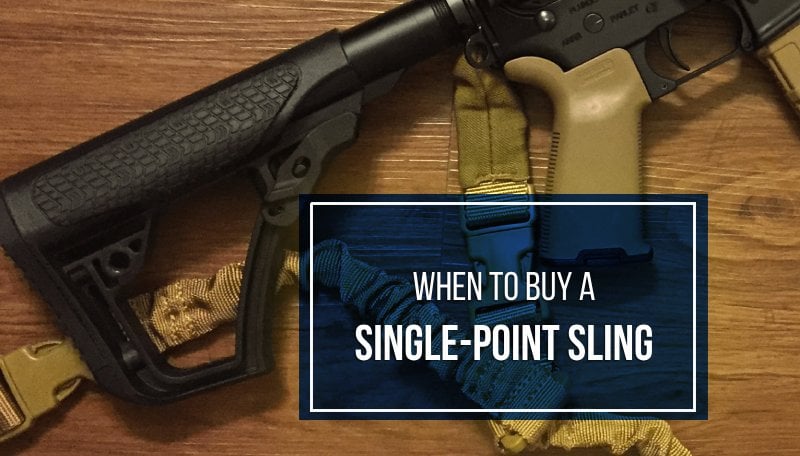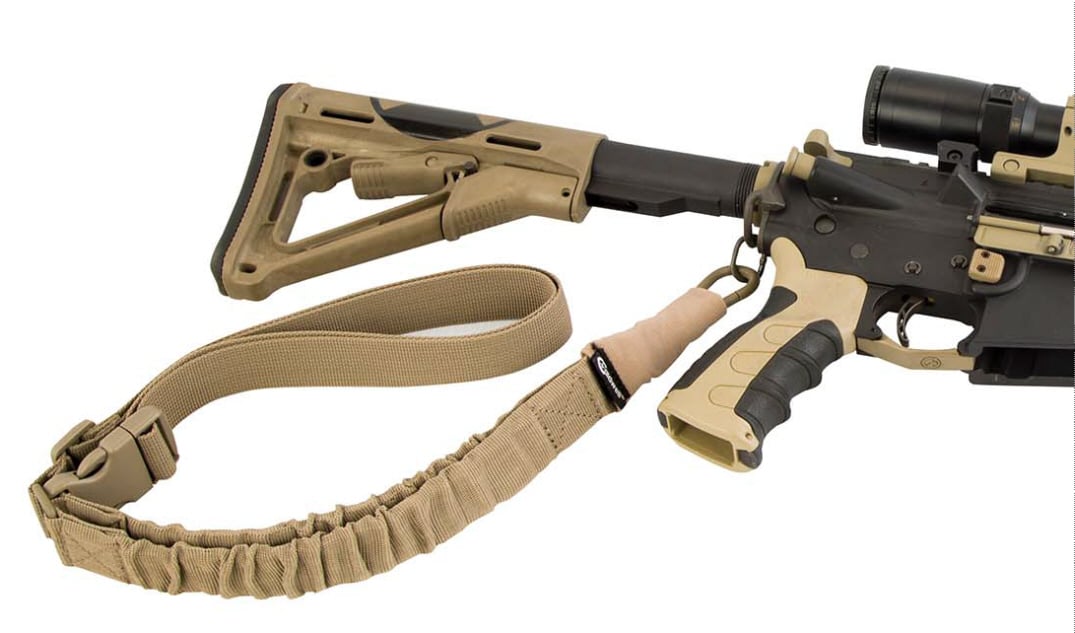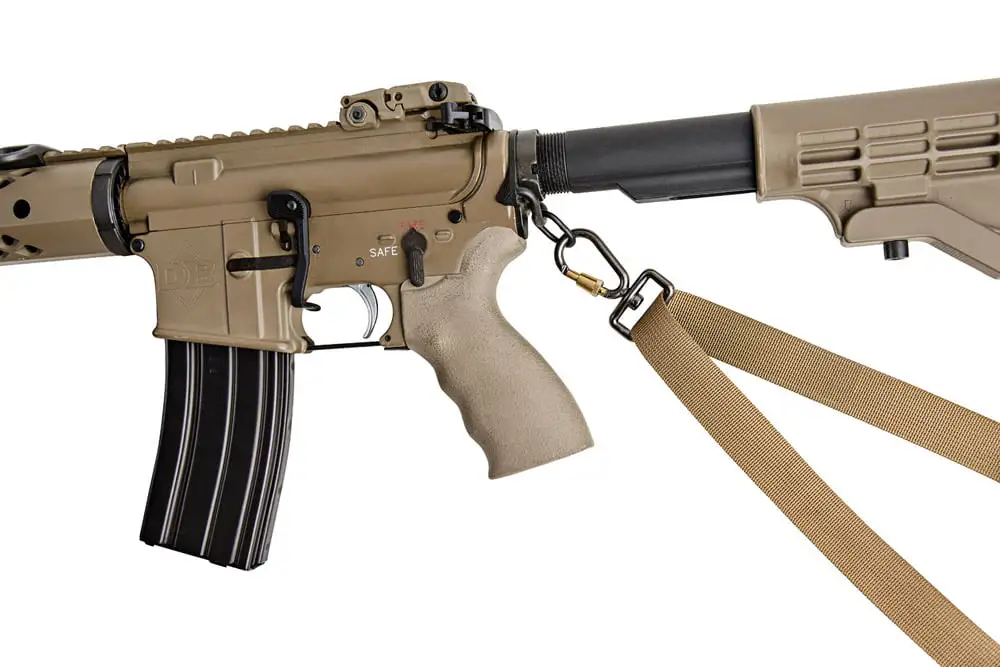
Found yourself wondering if an AR-15 single-point sling is the right fit for you? Let’s delve into the details to help you decide.
Table of Contents
What is an AR-15 Single Point Sling?

An AR-15 single-point sling is a sturdy strap you wear over one shoulder and across your torso. This strap connects to your AR-15 rifle at a single point, usually near the back end of the gun’s lower receiver. The design of this sling allows your rifle to hang directly in front of you, allowing you to swiftly move it from a resting position into action and giving you a lot more freedom to manipulate it.
1 Point vs. 2 Point Sling for AR-15 – Other Rifle Sling Types
When choosing an AR-15 shoulder strap, the decision often boils down to a single-point or a two-point sling.
As we mentioned earlier, the single-point sling attaches to your rifle at one point. Logically, a two-point sling attaches to the rifle at two points: usually one near the rear of the gun and another towards the front. As you know, the more contact points, the more stable the system. So a 2-point configuration gives less swinging around, especially when you’re on the move, allows for versatile carrying positions, and can be used to stabilize the rifle while aiming.
A less popular option includes a three-point sling (aka hands-free rifle sling) that attaches at three points, creating a loop around your body and the weapon. This design offers even greater stability and carrying versatility, particularly useful in situations where both hands need to be free.
So, as you can see, fewer points of contact make the system more maneuverable but less stable.
Advantages of the AR-15 Single-Point Sling
Speed of Use
One of the standout features of single-point slings is their speed of use. These slings keep the weapon in alignment with your body’s front center line, so it becomes incredibly straightforward for you to grasp the rifle when it’s at rest. The single-point sling allows you to swiftly bring your weapon into action.
Shoulder Transition
Another advantage of the single-point sling is its smoothness of shoulder transition. Though shoulder transition is a technique that is often associated with military or law enforcement training, some civilians also practice it. Some shooters try to do more weak side work than the strong side, which helps to develop their skills and competency on both sides, preparing them for any potential shooting scenarios.
So, whether you’re right-handed or left-handed, a 1-point sling simplifies the process of transitioning from one shoulder to the other, as the firearm is not attached to much, so there’s no extra slack to drag across.
No Sling Tangle
We’ve all been there – the frustrating moment when you’re trying to maneuver your way out of a tangled sling. But with a single-point sling, that’s not a problem. The design of the single-point sling forms a tight loop around your torso and keeps the gun free, reducing the chances of entanglement. 2 point slings, on the other hand, have more slack, and this extra length can easily get caught on gear.
Disadvantages of the AR-15 Single Point Sling
Inconvenient When Moving
With a single-point sling, your AR-15 hangs muzzle down when not in use. It obstructs movement, particularly when navigating tight spaces, kneeling, and bending. Imagine trying to climb a ladder or treat a medical emergency with a rifle swinging around your torso – not the most convenient, right? When using a 1-point sling, keep a hold of your rifle to prevent it from swinging randomly around.
Additionally, unlike two-point slings that distribute the weight of the firearm across your body, the entire weight of the gun is concentrated in one area with a single-point sling. It can lead to discomfort and fatigue during long periods of carry.
Minimal Gun Security
Single-point slings don’t offer a high level of security for your firearm. The gun is essentially hanging freely from the sling, which makes it an easy target for someone to grab. If you find yourself in a close-quarters situation, a threat could potentially get their hands on your rifle.
Risk of Injury
This one is specifically for men. Yep, you’ve got that right. With a single-point sling, if you release your AR-15 to transition to your sidearm, the rifle will swing down and fall right between your legs. Ouch! It’s not just uncomfortable – it can cause injury if you’re moving quickly or not paying attention to how the gun is swinging. It is a risk that’s unique to single-point slings.
Choosing the Best Sling for Your AR
Best AR-10 Sling. The AR-10 is a larger, heavier rifle chambered in powerful calibers like the .308 Win. The length of a standard AR-10 is more than 40 inches, with a barrel length of 20 inches, while the weight is more than 10 lbs. Though there are AR-10s with a shorter barrel of 16 or even 12 inches long, many are still quite heavy, especially with optics attached. Given the size and weight, a two-point sling is a better choice here.
Best AR-15 Sling. The AR-15 is smaller and lighter than the AR-10, so both single-point and two-point slings can work well with this rifle style. But a 1-point sling is most optimal for short-term operations. However, if you move a lot and need to keep your hands free, better opt for a 2-point sling.
Best M4 Carbine Sling. The M4 is a carbine version of the AR-15 with a shorter barrel. A classic M4 has a barrel length of 14.5 inches. So a single-point sling works best. A 1-point is also the best sling for an AR pistol.
How to Attach an AR-15 Single Point Sling?

Find the Attachment Point: The single-point sling is typically attached to the top rail or buffer tube of your AR-15, just behind or above the pistol grip.
Install the Sling Adapter: If your rifle doesn’t have a built-in sling attachment point, you’ll need to install a sling mount.
Attach the Sling: After securing the sling adapter, you can clip the sling onto the attachment point. Fasten securely to prevent accidental detachment.
(How to) Wear a Single Point Sling: Once attached, place the loop of the sling over your head. One strap should rest on your dominant shoulder and go under your opposite arm. This configuration should leave the rifle hanging in front of your body, ready for quick deployment.
Wrapping Up
A single-point sling:
- Allows for the best maneuverability and quickest shoulder transitions;
- Pairs ideally with AR-style SBRs, M4 carbines, and AR pistols.
- Requires constant hold of a rifle when on the move, which makes it best used for short-term operations.
- For maximum versatility, consider opting for a 1-point sling convertible to a 2-point sling.
- If you’re hunting for the best single-point tactical slings for the AR-15, consider the Magpul MS4 Sling Gen2 convertible to a two-point sling.
If you want to learn more about the other types of rifle slings, read our Rifle Slings Comparison guide.
FAQ
What is a single-point sling?
A single-point sling is a type of firearm sling that attaches to your gun at one point, typically near the rear of the weapon. It allows for easy maneuverability.
How do I attach a single-point sling to my firearm?
Single-point slings attach at the top rail or buffer tube just behind or above the pistol grip. If your rifle doesn’t have a built-in sling attachment point, you’ll need to install a sling mount.
Why would I use a single-point sling?
Single-point slings are great for situations where you need to quickly maneuver your firearm, like in close-quarters combat.
How should I wear a single-point sling?
Place the loop of the sling over your head. The strap should rest on your dominant shoulder and go under your opposite arm. This should leave the rifle hanging in front of your body.




Leave a Reply